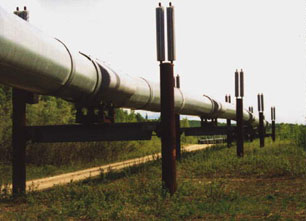
Image Credit: Courtesy of Donald D. Rice. |
Basic Facts About Pipelines
The invention of the seamless, electrically-welded pipe in the 1920's which was capable of carrying material under high pressures, enabled the building of profitable pipelines over a thousand miles long. Now the United States and other parts of the world are criss-crossed by large networks of pipelines that carry natural gas, petroleum products, water and other materials from their sources to consumers. The pressure in the pipes ranges from 50 to 2000 pounds per square inch. Every 30 to 150 miles, compressor stations for the natural gas and pumping stations for the liquid and solid products boost the pressure and send the material along the pipeline. The pipelines, which are mostly buried under the ground can develop leaks due to damage from freezing temperatures, heavy rains, soil erosion and corosion. The pipelines are usually coated with tar or some other substance to protect them from corosion. Corosion is due to chemical reactions between the material of the pipeline and the natural environment. |
The U.S. has some very extensive pipeline networks. The longest, which is 2000 miles ( 3200 kilometers) longwith 8000 miles (13,000 kilometers) of branch lines, carries natural gas from Baton Rouge, LA to Pittsbrugh, PA and New York City. Another famous pipeline in the U.S. is the Trans-Alaskan Pipeline. About 1/2 of this pipeline is buried underground. It runs 800 miles (1300 kilometers) from the rich oil fields near Prudhoe Bay on the Arctic Ocean to Valdez on the southern coast of Alaska. In the process it crosses 20 large rivers, 300 streams and 3 mountain ranges. The Former Soviet Union (FSU) has the world's longest pipelines, one running 3800 miles (6,120 kilometers) from the Ural Mountains to Eastern Europe and the other running 2500 miles (4,000 kilometers) from Siberia to Austria, East Germany, France, Italy and West Germany. The Trans-Alaskan Pipeline, the FSU pipelines, and others that are located at high latitudes are particularly susceptible to the affects of space weather disturbances. |
Impacts of Space Weather Disturbances Pipelines are made of conducting material. Intense electric currents flow in the atmosphere at high latitudes during space weather disturbances. These nonsteady currents create fluctuating magnetic fields that are felt at the Earth's surface. By the process of electromagnetic induction, fluctuating magnetic fields induce currents in the Earth's surface. In regions, with large concentrations of rocks that don't conduct electricity well (such as igneous rocks) the currents find the paths of least resistance and become concentrated in man-made conductors like pipelines. The currents flow between the Earth and the pipeline causing increased corrosion of the pipeline.
|





